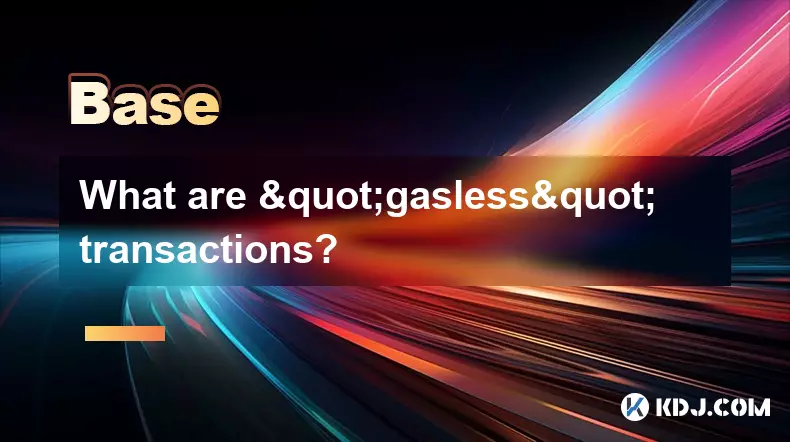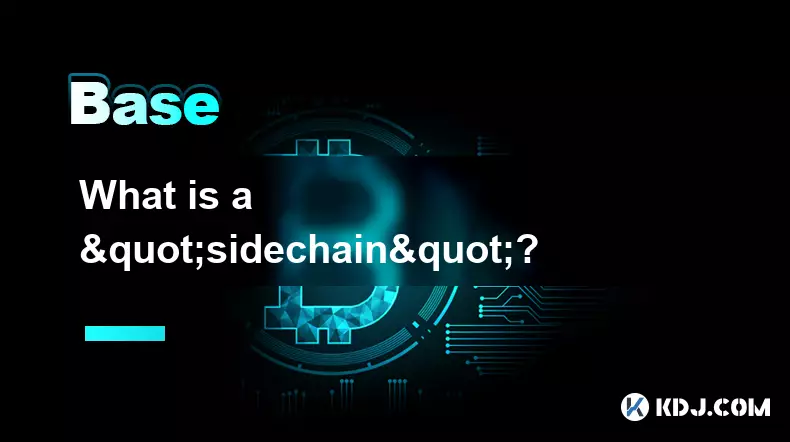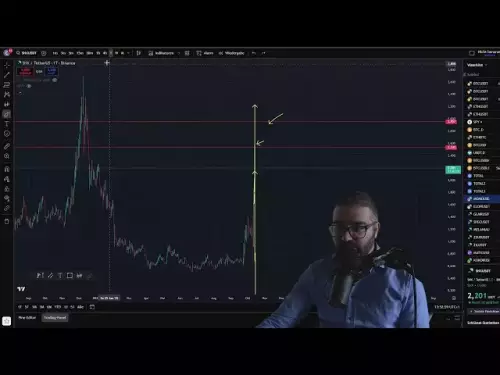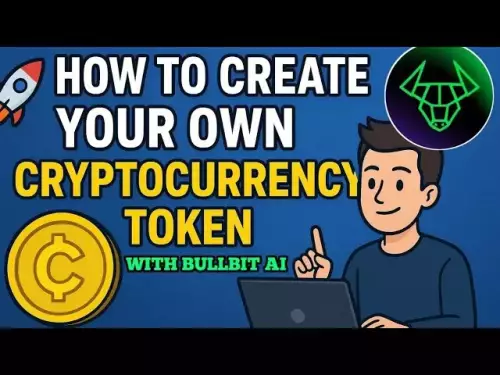-
 bitcoin
bitcoin $115692.075601 USD
5.13% -
 ethereum
ethereum $4162.931611 USD
11.68% -
 bnb
bnb $1310.063287 USD
17.56% -
 tether
tether $1.000983 USD
0.00% -
 xrp
xrp $2.534505 USD
8.16% -
 solana
solana $198.235737 USD
13.49% -
 usd-coin
usd-coin $1.000236 USD
0.02% -
 dogecoin
dogecoin $0.207352 USD
12.89% -
 tron
tron $0.323043 USD
3.62% -
 cardano
cardano $0.701559 USD
11.88% -
 hyperliquid
hyperliquid $39.924597 USD
8.30% -
 chainlink
chainlink $18.934457 USD
11.56% -
 ethena-usde
ethena-usde $1.000552 USD
0.02% -
 stellar
stellar $0.340575 USD
7.05% -
 bitcoin-cash
bitcoin-cash $545.011757 USD
8.86%
What are "gasless" transactions?
Gasless transactions let users interact with dApps without paying gas fees, improving accessibility by shifting costs to relayers or sponsors.
Oct 12, 2025 at 05:00 pm

Understanding Gasless Transactions in the Crypto Space
1. In blockchain networks like Ethereum, every transaction requires a fee known as 'gas' to compensate miners or validators for processing and securing the transaction. This fee varies based on network congestion and computational complexity. However, gasless transactions offer an alternative mechanism where users can interact with smart contracts or transfer assets without directly paying gas fees.
2. Gasless transactions are made possible through advanced cryptographic techniques such as meta-transactions. In this model, a third party—often called a relayer—pays the gas fee on behalf of the user. The actual sender signs the transaction off-chain, and the relayer submits it to the blockchain, covering the cost. This allows end users to engage with decentralized applications (dApps) seamlessly, especially those who may not hold native tokens required for gas.
3. A key component enabling gasless functionality is the use of ERC-2771 or similar standards. These standards allow dApps to identify the original sender of a meta-transaction even though it was submitted by a relayer. This preserves security and ensures that contract logic treats the real user as the initiator, preventing impersonation and maintaining trustless execution.
4. Projects focused on improving user experience often adopt gasless models during onboarding. For instance, new users might mint NFTs or claim tokens without needing ETH in their wallet. This removes one of the biggest friction points in Web3 adoption: acquiring cryptocurrency solely to pay for transaction fees before engaging with a platform.
5. While convenient, gasless transactions shift the financial burden from the end user to the service provider or sponsor. DApps may absorb these costs as part of their operational expenses, funded through venture capital, token emissions, or revenue streams. Alternatively, sponsors can subsidize interactions selectively—for example, offering free trades up to a certain limit on a decentralized exchange.
How Gasless Models Empower User Adoption
1. One of the most significant barriers to mainstream blockchain adoption is the complexity associated with managing multiple tokens for different purposes. Gasless transactions eliminate the need for users to understand or acquire native chain tokens just to begin using decentralized services. This simplification makes dApps more accessible to non-technical audiences.
2. Onboarding flows become significantly smoother when users can sign up, verify identity, or execute initial actions without funding a wallet. Startups leveraging gasless architectures report higher conversion rates because potential users aren’t deterred by the upfront requirement to purchase cryptocurrency.
3. Gaming and social platforms benefit greatly from gasless designs. Players can mint in-game items, level up characters, or participate in governance votes without ever touching gas fees. Creators launching community tokens or distributing rewards can ensure broad participation regardless of followers’ wallet balances.
4. Enterprises exploring private or consortium blockchains also utilize gasless mechanisms internally. Since participants are known entities, the network operator can centrally manage transaction costs, making the system appear frictionless to employees or partners interacting with the ledger.
5. Some protocols implement dynamic sponsorship systems where developers register relayers and set rules for which functions are subsidized. Users trigger specific actions—like voting in a DAO—that are pre-approved for gasless execution, while other operations require standard payment. This selective approach balances usability with long-term sustainability.
Security and Economic Implications
1. While gasless transactions improve accessibility, they introduce new attack vectors. Malicious actors could spam relayers with low-value requests, forcing them to spend large amounts on gas unless proper rate-limiting and validation layers are implemented. Robust filtering mechanisms are essential to prevent abuse.
2. Relayers must be trusted to forward transactions faithfully and not censor or reorder them. Decentralized relayer networks help mitigate this risk by distributing submission rights across multiple independent nodes, reducing reliance on any single entity.
3. Economically, prolonged subsidization of gas fees isn't viable for most projects unless backed by strong funding or alternative monetization strategies. Over time, teams may transition from fully gasless models to hybrid systems where only core functionalities remain free, encouraging organic token usage.
4. Smart contract audits become even more critical in gasless environments. If a contract fails to properly authenticate the original sender via standardized interfaces like IERC2771, attackers could exploit the relayer layer to impersonate users or escalate privileges within the application.
5. Transparency about who pays for transactions and under what conditions builds trust. Leading platforms disclose their sponsorship policies clearly, allowing users to anticipate potential changes in availability or cost structure as the ecosystem evolves.
Frequently Asked Questions
What enables a transaction to be gasless if blockchains require gas?Gasless transactions still consume gas on the network, but the fee is paid by a third party rather than the end user. The actual computation and storage costs are covered by relayers or sponsors, giving the illusion of zero-cost interaction from the user’s perspective.
Can anyone become a relayer in a gasless system?In open implementations, yes—anyone can operate a relayer node if the protocol allows public participation. These nodes listen for signed meta-transactions, validate them, and submit them to the blockchain. Operators may earn incentives through bounties, reputation systems, or direct payments from dApp developers.
Are gasless transactions slower than regular ones?Not inherently. Once a relayer picks up a signed message, the transaction enters the mempool like any other. Speed depends on the relayer’s configuration and current network conditions, not the fact that it's a meta-transaction.
Do gasless transactions work across all blockchains?They are primarily available on EVM-compatible chains supporting smart contract logic necessary for meta-transactions. Networks like Ethereum, Polygon, BSC, and Arbitrum have active implementations. Non-EVM chains would require custom solutions to achieve similar functionality.
Disclaimer:info@kdj.com
The information provided is not trading advice. kdj.com does not assume any responsibility for any investments made based on the information provided in this article. Cryptocurrencies are highly volatile and it is highly recommended that you invest with caution after thorough research!
If you believe that the content used on this website infringes your copyright, please contact us immediately (info@kdj.com) and we will delete it promptly.
- XRP Price Prediction: Weekend Rollercoaster or Rally?
- 2025-10-12 08:45:16
- Bittensor (TAO): Super Bullish Signals Point to Potential 2x Rally
- 2025-10-11 10:25:12
- Silver Price Correction: Navigating the Dip & Identifying Key SEO Keywords
- 2025-10-11 10:25:12
- Decoding Crypto Trends: Bittensor's Bull Run, Cardano's Dip, and LivLive's Presale Buzz in 'Uptober 2025'
- 2025-10-12 08:45:16
- MoonBull: The Crypto Meme Coin Promising 1000x Gains?
- 2025-10-11 10:30:01
- Crypto Payroll Revolution: Stablecoins, Altcoins, and the Future of Salary Payments
- 2025-10-11 10:30:01
Related knowledge

What does it mean for code to be "open source" in crypto?
Oct 12,2025 at 01:54pm
Understanding Open Source in the Cryptocurrency Ecosystem1. In the context of cryptocurrency, open source refers to software whose code is publicly ac...

What is the purpose of a "testnet"?
Oct 12,2025 at 09:01am
Understanding the Role of Testnets in Blockchain Development1. A testnet serves as a parallel version of a blockchain network, designed specifically f...

How to avoid phishing scams in crypto?
Oct 13,2025 at 06:18pm
Understanding Common Crypto Phishing Tactics1. Cybercriminals frequently use fake websites that mirror legitimate crypto exchanges or wallet platforms...

What is the difference between single-collateral and multi-collateral Dai?
Oct 12,2025 at 05:18pm
Understanding Single-Collateral Dai1. Single-Collateral Dai (SCD) was the original version of the Dai stablecoin launched by MakerDAO in 2017. It allo...

What is a "sidechain"?
Oct 13,2025 at 02:36pm
Understanding the Concept of Sidechains1. A sidechain is a blockchain that operates independently but is connected to another blockchain, known as the...

What is "EIP-1559" and how did it change Ethereum?
Oct 12,2025 at 03:00am
Understanding EIP-1559 and Its Core Mechanism1. EIP-1559 is a protocol upgrade introduced to the Ethereum blockchain as part of the London hard fork i...

What does it mean for code to be "open source" in crypto?
Oct 12,2025 at 01:54pm
Understanding Open Source in the Cryptocurrency Ecosystem1. In the context of cryptocurrency, open source refers to software whose code is publicly ac...

What is the purpose of a "testnet"?
Oct 12,2025 at 09:01am
Understanding the Role of Testnets in Blockchain Development1. A testnet serves as a parallel version of a blockchain network, designed specifically f...

How to avoid phishing scams in crypto?
Oct 13,2025 at 06:18pm
Understanding Common Crypto Phishing Tactics1. Cybercriminals frequently use fake websites that mirror legitimate crypto exchanges or wallet platforms...

What is the difference between single-collateral and multi-collateral Dai?
Oct 12,2025 at 05:18pm
Understanding Single-Collateral Dai1. Single-Collateral Dai (SCD) was the original version of the Dai stablecoin launched by MakerDAO in 2017. It allo...

What is a "sidechain"?
Oct 13,2025 at 02:36pm
Understanding the Concept of Sidechains1. A sidechain is a blockchain that operates independently but is connected to another blockchain, known as the...

What is "EIP-1559" and how did it change Ethereum?
Oct 12,2025 at 03:00am
Understanding EIP-1559 and Its Core Mechanism1. EIP-1559 is a protocol upgrade introduced to the Ethereum blockchain as part of the London hard fork i...
See all articles










































































